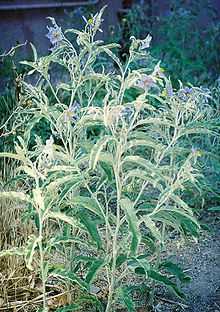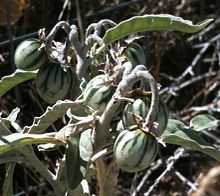Solanum elaeagnifolium
- This article is about the Solanum elaeagnifolium described by A. J. Cavanilles. The plant described under the same name by W. Herbert and C. L. Willdenow based on E.G. von Steudel is S. aethiopicum.
| Silver-leaved Nightshade | |
|---|---|
 | |
| Plant with flowers, unripe berries (green with stripes, center), and previous year's berries (orange, upper left) | |
| Scientific classification | |
| Kingdom: | Plantae |
| (unranked): | Angiosperms |
| (unranked): | Eudicots |
| (unranked): | Asterids |
| Order: | Solanales |
| Family: | Solanaceae |
| Genus: | Solanum |
| Species: | S. elaeagnifolium |
| Binomial name | |
| Solanum elaeagnifolium Cav. | |
| Synonyms | |
|
See text | |
Silver-leaved Nightshade or Silverleaf nightshade, Solanum elaeagnifolium, is a common weed of western North America and also found in South America. Other common names include Prairie Berry, Silverleaf Nettle, White Horsenettle or Silver Nightshade. In South Africa it is known as Silver-leaf bitter-apple or satansbos ("Satan's Bush" in Afrikaans). More ambiguous names include "bull-nettle", "horsenettle" and the Spanish "trompillo".[1]
Description and ecology
It is a perennial 10 cm[2] to 1 m in height. The stems are covered with nettle-like prickles,[3] ranging from very few on some plants to very dense on others. Leaves and stems are covered with downy hairs (trichomes) that lie against and hide the surface, giving a silvery or grayish appearance.[4]


The leaves are up to 15 cm long and 0.5 to 2.5 cm wide, with shallowly waved edges, which distinguish it from the closely related Carolina Horsenettle (S. carolinense), which has wider, more deeply indented leaves. The flowers, appearing from April to August, have five petals united to form a star, ranging from blue to pale lavender or occasionally white; five yellow stamens and a pistil form a projecting center. The plant produces glossy yellow, orange, or red berries that last all winter and may turn brown as they dry.[4]
Its range is from Kansas south to Louisiana, and west through the Mexican-border states of the United States into Mexico, as well as Uruguay, Argentina, and Chile.[5] It may have originated in North America and was accidentally introduced to South America[6] or the reverse.[5] It can grow in poor soil with very little water. It spreads by rhizomes as well as seeds, and is common in disturbed habitats. It is considered a noxious weed in 21 U.S. states and in countries such as Australia, Egypt, Greece, India, Israel, Italy, South Africa, and Zimbabwe.[7] It is toxic to livestock and very hard to control, as root stocks less than 1 cm long can regenerate into plants.[8] However, some gardeners encourage it as a xeriscape ornamental.
The Pima Indians used the berries as a vegetable rennet, and the Kiowa used the seeds together with brain tissue to tan leather.[6]
Synonyms

This plant has been described under a range of names, all now invalid. These contain many homonyms among them:[9]
- Solanum dealbatum Lindl.
- Solanum flavidum Torr.
- Solanum incanum Pav. ex Dunal (non L.: preoccupied)
- S. incanum of Ruiz & Pavón Jiménez is S. albidum as described by Dunal.
- S. incanum of Kitaibel based on Kanitz is S. villosum as described by Philip Miller
- S. incanum of Scheff. is S. schefferi.
- S. incanum var. lichtensteinii and var. subexarmatum are S. lichtensteinii.
- Solanum leprosum Ortega
- Solanum obtusifolium Dunal (non Willd.: preoccupied)
- S. obtusifolium of Hartweg based on Otto Sendtner in von Martius is S. ferrugineum.
- S. obtusifolium of Willdenow is S. aethiopicum.
- Solanum pyriforme var. uniflorum Dunal
- Solanum roemerianum Scheele
- Solanum saponaceum Hook. (non Dunal: preoccupied)
- S. saponaceum of Welwitsch is S. aculeastrum.
- S. saponaceum var. uruguense is S. bonariense.
- Solanum texense Engelm. & A.Gray
- Solanum uniflorum Meyen ex Nees (non Dunal: preoccupied)
- S. uniflorum of de Conceição Vellozo is S. pseudocapsicum.
- S. uniflorum of Sessé & Mociño and S. uniflorum of Dunal in Poiret have been identified as Lycianthes mociniana.
- S. uniflorum of Lagasca y Segura and Solanum uniflorum var. berterianum are undetermined species of Lycianthes.
Several varieties and forms of S. elaeagnifolium have been named. They are not usually considered taxonomically distinct:[9]
- Solanum elaeagnifolium f. albiflorum Cockerell
- Solanum elaeagnifolium var. angustifolium Kuntze
- Not to be confused with S. angustifolium of Philip Miller
- Solanum elaeagnifolium var. argyrocroton Griseb.
- Solanum elaeagnifolium f. benkei Standl.
- Solanum elaeagnifolium var. grandiflorum Griseb.
- Not to be confused with S. grandiflorum of Ruiz and Pavón Jiménez
- Solanum elaeagnifolium var. leprosum (Ortega) Dunal
- Solanum elaeagnifolium var. obtusifolium (Dunal) Dunal
S. elaeagnifolium var. ovalifolium does not refer to the S. ovalifolium as described by Dunal and does not belong to the present species; it is actually S. aridum. Meanwhile, S. crispum var. elaeagnifolium is just the normal S. crispum of Ruiz and Pavón Jiménez.[9]
References
- ↑ Cronquist et al. (1984), USDA (2006)
- ↑ Niehaus et al. (1984)
- ↑ "Solanum elaeagnifolium Cav.". Native Plant Database. The University of Texas at Austin. June 25, 2008. Retrieved November 21, 2011.
- ↑ 4.0 4.1 Cronquist et al. (1984)
- ↑ 5.0 5.1 USDA (2006)
- ↑ 6.0 6.1 WSNWCB (2008)
- ↑ Nugent (2005), WSNWCB (2008)
- ↑ CDFA [2008]
- ↑ 9.0 9.1 9.2 Solanaceae Source [2008]
Footnotes
| Wikimedia Commons has media related to Solanum elaeagnifolium. |
- California Department of Food and Agriculture (CDFA) [2008]: Encycloweedia – Solanum part 2. Retrieved 2008-SEP-26.
- Cronquist, Arthur; Holmgren, Arthur H.; Holmgren, Noel H.; Reveal, James L. & Holmgren, Patricia K. (1984): Intermountain Flora; Vascular Plants of the Intermountain West, U.S.A. (Vol. 4. Subclass Asteridae except Asteraceae). The New York Botanical Garden. ISBN 0-89327-248-5
- Niehaus, Theodore F.; Ripper, Charles L. & Savage, Virginia (1984): A Field Guide to Southwestern and Texas Wildflowers. Houghton Mifflin Company, ISBN 0-395-36640-2
- Nugent, Martin (ed.) (2005): Oregon Invasive Species Action Plan. PDF fulltext
- Solanaceae Source [2008]: Solanum elaeagnifolium. Retrieved 2008-SEP-26.
- United States Department of Agriculture (USDA) (2006): Germplasm Resources Information Network - Solanum elaeagnifolium. Version of 2006-JAN-14. Retrieved 2008-SEP-26.
- Washington State Noxious Weed Control Board (WSNWCB) (2008): Silverleaf Nightshade. Version of 2008-JUL-09. Retrieved 2008-SEP-26.